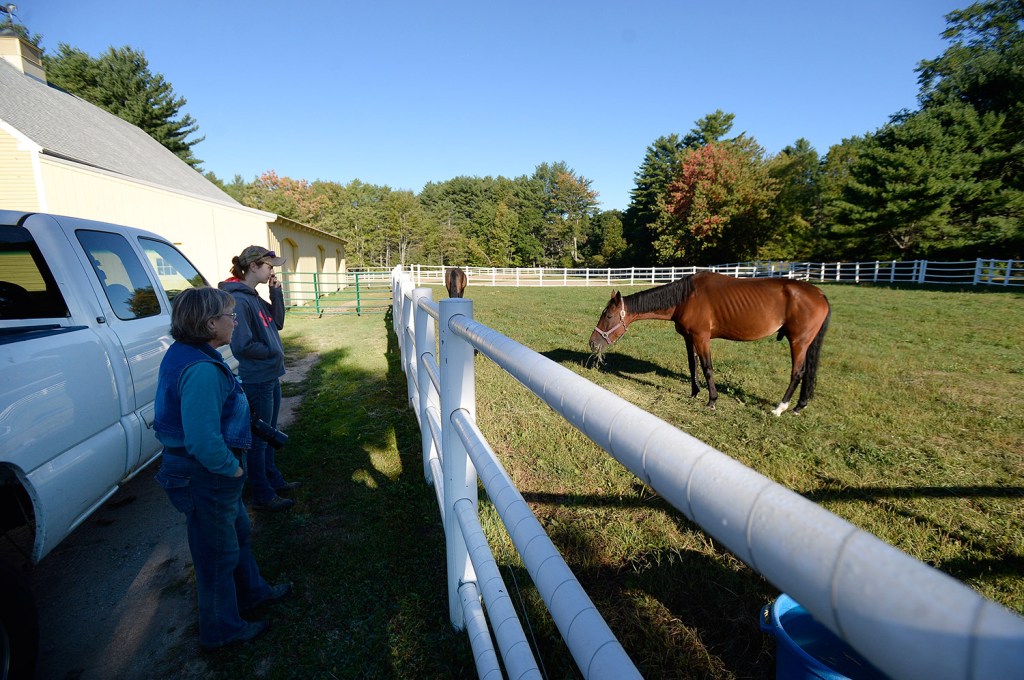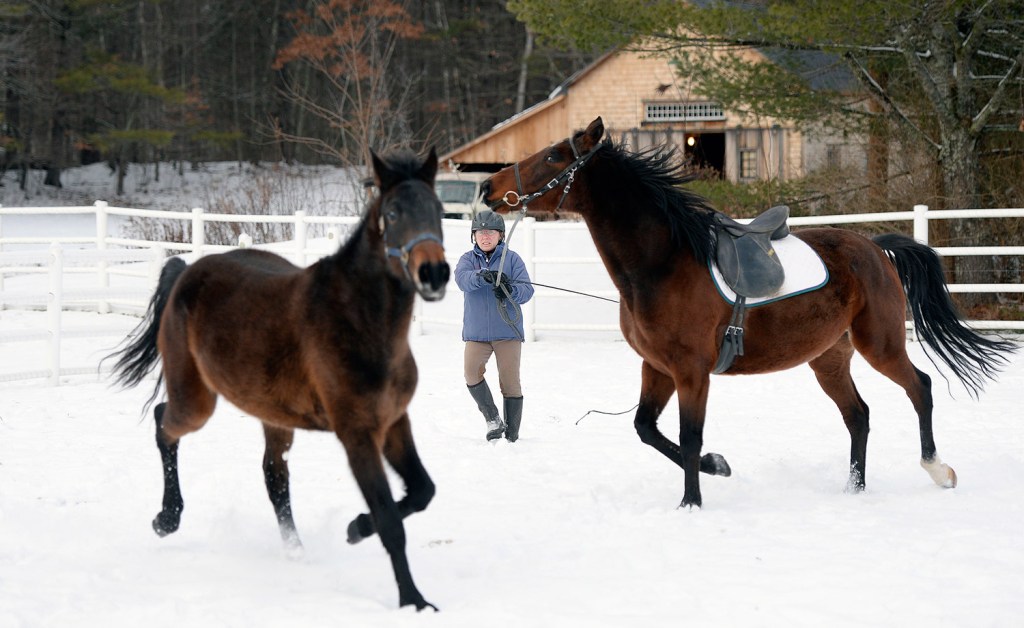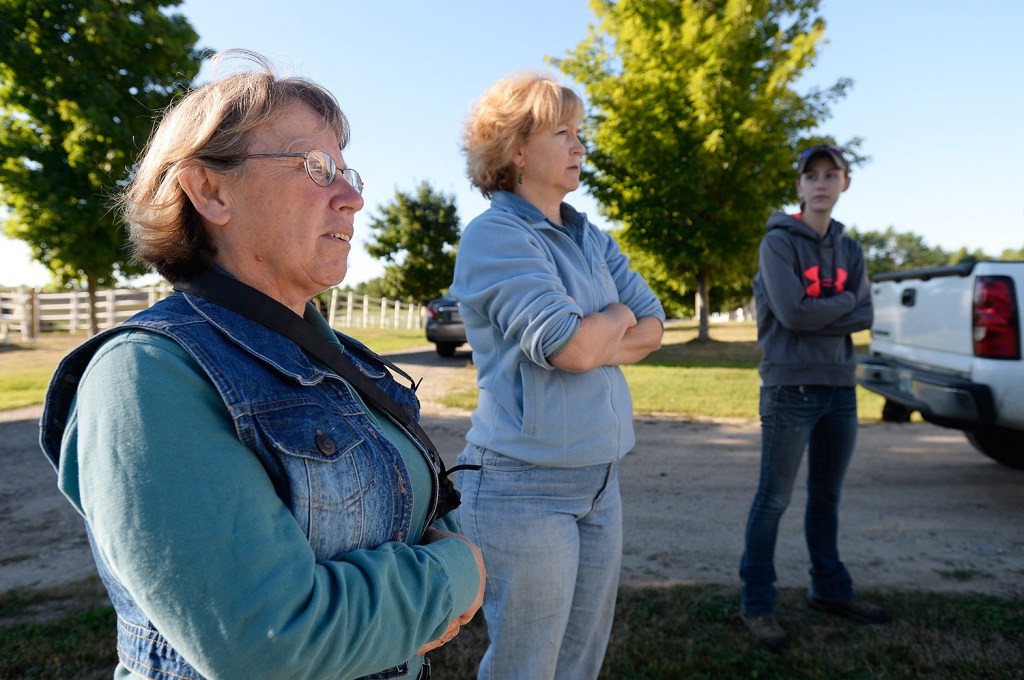HOLLIS — When Yankee arrived at Joy Cutrone’s farm in mid-September, the 10-year-old racehorse was in sorry shape.
Yankee had earned more than $50,000 for his original owners in his five-year harness racing career, but three years after his last race he was in the back of an animal control officer’s trailer, feverish, severely underweight and suffering from a bruised hoof. A previous owner had planned to send him to a slaughterhouse. The veterinarian who evaluated him for Cutrone offered euthanization.
Cutrone, who rescues distressed horses one pair at a time at her Hollis farm, decided to give the horse a chance. Three months later, Yankee and another racehorse he arrived with are still sick but on the road to recovery.
“We don’t know what happened to him between the date of his last race and when he ended up on the truck bound for slaughter,” says Cutrone, who is starting to retrain him.
Horse rescuers estimate that dozens of retired Maine harness racing horses each year are euthanized or shipped to Quebec or Mexico for slaughter. Perhaps a hundred more are bought by the Amish, who buy them at Maine racetracks to pull the buggies they use for daily transportation, where horse rescuers says the work is hard, cutting lives short.
It’s the uncomfortable secret of Maine’s harness racing industry: Each year, some 200 horses end their racing career at ages 3 to 14 but will live to be 30. Although the public subsidizes the industry through $8 million in annual allocations from the state’s two casinos, none of that money has ever been earmarked for the retiring horses, which require retraining to be used with saddles rather than buggies.
“Nobody wants to know where all these horses go when they retire, often at 3,” says Robyn Cuffey of Buxton, founder of the Standardbred Pleasure Horse Organization of Maine, who literally wrote the manual on how to retrain Standardbreds – the breed used in harness racing – to be saddle horses. “I’ve been working with these horses for 30 years, and I’m still trying to figure out why the people who made all the money off these horses are not putting a dime back into taking care of them afterward.”
Cutrone says the industry as a whole is responsible – not just racehorse owners but the tracks and the casinos as well. “A portion of the millions of dollars (from gambling allocations) should be dedicated to aftercare, to close the loop on the remaining decades of the average horse’s life span,” she says.
Advocates of retiring horses see a potential opportunity with the likely closure of Scarborough Downs, the state’s largest racetrack, which went up for sale last month and sits on a 483-acre plot that has been long talked about as a potential site to develop a downtown for Scarborough. If it were to close, the $3 million the racetrack gets in casino disbursements each year would be retained by the Maine Harness Racing Commission. Much of those funds – perhaps half – would likely not be redistributed to Maine’s other tracks, as they are tied to race starts and the other tracks are unlikely to be able to absorb the 101 the Scarborough track runs each year.
The horse advocates would like the Legislature to redirect some of those unclaimed funds to help retired horses by creating a retraining facility. “How progressive would the Maine racing industry be if we were to be the first in the nation with an answer to the problem of aftercare for racehorses,” says Cutrone, who argues that such a facility would benefit not only the animals but a range of potential users, from school groups and recreational riders to recovering substance abusers and at-risk teens.
Cuffey, who has run a rescue and retraining operation for 30 years, estimates such a facility would cost $500,000 to create and that it could sustain itself through its own fundraising and the dividends on an endowment of around $4.5 million. The funds would presumably be allocated over several years.
By comparison, in 2015 the harness racing industry received $8.44 million in casino allotments, with Scarborough Downs receiving about $3 million, two-thirds of it earmarked for purse money. Maine’s other permanent racetrack, the Bangor Raceway, is operated by Hollywood Casino.
“The whole goal would be to retrain them and find them new homes to get them out of the system and keep the money circulating,” says Cuffey, who rescues and rehabilitates horses two at a time because she can’t afford to take on more. “For years I spent $200 a month on each horse and might have them three to six months and then give them away because there isn’t a big market for them.”
‘PIPE DREAM’ FOR INDUSTRY IN CRISIS
Leaders of the harness racing community have a different point of view, both on the scale of the problem and the practicality of funding a permanent solution at a time when the industry is in crisis.
Rep. Don Marean, R-Hollis, a member of the board of the Maine Harness Horsemen’s Association and a longtime legislative champion of the industry, says the idea is a “pipe dream” and that the industry is in no position to divert casino revenues.
“The entire industry is struggling to stay afloat with the competition from the casinos and … online gambling,” said Marean, who raised Standardbreds with his wife at his Hollis farm for many years. “So this probably isn’t a good time to be redistributing an already declining revenue stream.”
Maine’s first casino, Hollywood Casino, was authorized by voters in a 2003 ballot measure as a way to support the struggling harness racing industry. By law, it must distribute about 40 percent of its net revenues to a variety of interests, from a University of Maine scholarship fund (2 percent) to the state’s General Fund (4 percent). The harness racing industry gets 8 percent of the net revenues, half going to the racetracks with no strings attached, the rest to supplement the purses given to the owners of winning horses at the races.
Under a revision to Maine law that Marean spearheaded this year, if Scarborough Downs were to close, any unallocated funds will be diverted to pay the operating costs of the Maine Harness Racing Commission, which is funded by fees on the industry.
Harness racing attendance and wagers have long been in decline, and the tens of millions in casino subsidies diverted to support the industry over the past decade haven’t fostered a turnaround. When Maine voters authorized racetrack slot parlors in 2003, the industry expected there to be two of them – one near the Bangor Raceway, the other near Scarborough – but local voters rejected plans for the latter. “If we’d had that, the industry would be competitive,” Marean said.
Ultimately, instead of a racetrack casino – or racino – southern Maine got the Oxford Casino, which operates under different legislation and provides just 1 percent of its net revenues to support harness racing, compared with 8 percent at Bangor’s Hollywood Casino. “The 1 percent we get from Oxford doesn’t even make up for what we’ve lost from the competition,” Marean says.
A company spokesman told the Maine Sunday Telegram that Scarborough Downs’ revenue had declined from $4.2 million in 2004 to $2.8 million in 2015.
INDUSTRY QUESTIONS SCALE OF PROBLEM
While he agreed with Cuffey’s estimate that around 200 horses are retired from harness racing in a typical year, Marean also questioned whether there really were scores of them in need of help. “The numbers you are getting are fabricated on emotion and the need of some rescues looking for monetary support,” he said.
Diann Perkins, president of the Maine Standardbred Breeders and Owners Association, represents owners of Maine-bred horses. “I wouldn’t call it a problem,” she says. “We have some great organizations that are trying to revitalize them because they make excellent retirement horses for people.”
Nobody keeps track of how many horses retire from Maine tracks each year. Neither the Maine Harness Horsemen’s Association nor the Maine Standardbred Breeders and Owners Association keeps such data, and a spokeswoman for the national governing body, the U.S. Trotting Association, said its database of all individual horses wasn’t set up to calculate such information.
“There’s a variety of options for retiring horses,” said Ellen Harvey, USTA’s director of harness racing communications. “A very large percentage of the females go on to be moms and produce the next generation of horses, and a small percentage of the males would be the dads in that situation. The rest of them need jobs.”
The industry has several initiatives to aid horses that end up distressed. A national database helps former owners track the whereabouts of 8,000 horses, allowing them to buy them back if they’re in trouble. Marean, who sits on USTA’s board, spearheaded the creation of Support Our Standardbreds, a program that gives payments to nonprofits involved in rescuing horses that were so neglected or mistreated by their owners that they were seized by law enforcement.
Since 2012, the Maine Harness Horsemen’s Association contributed $5,000 a year to a fund to help distressed horses. For the past three years, Hollywood Casino – with net revenues of $44.2 million – donated $1 per race starter to the fund, or about $3,900 a year. The fund gives a $500 to $1,000 donation per horse to approved rescue farms.
Those funds, while appreciated, are a drop in the bucket, those involved in horse rescue say. They go only to horses that are already in such distress that authorities have taken them from their owners, and cannot be used to buy and retrain a horse otherwise bound for a slaughterhouse. Gifts from the Maine fund and USTA typically amount to $500 per horse, but it costs thousands of dollars a year to feed and care for each animal, says Meris Bickford, chief executive officer of the Maine Society for the Protection of Animals in Windham, the largest horse rescue facility in New England, where most horses seized by Maine law enforcement wind up.
‘A FANTASTIC TRAIL-RIDING HORSE’
Maine authorities actually seize, on average, just five or six Standardbreds a year, Bickford estimates. “They’re brood mares that are used up and too old to produce more foals or horses with undistinguished racing careers for whom the economics are unappealing for the owners,” she says. “The brood mares are sweet, but they have no money-making skills whatsoever.”
The facility – which is housing 69 horses of various breeds – works only with seized animals. “If we took in the horses people want to surrender we would have to be 10 times the size,” Bickford says.
It is unclear how many Standardbreds wind up slaughtered for human consumption. In 2013, the American Society for the Protection of Animals told lawmakers that each year 1,500 Maine horses of all breeds were sent to slaughterhouses in Quebec and Mexico. (The last U.S. horse slaughterhouse closed in 2007.) It said 92 percent were in good condition and could have gone to new owners.
Steuart Pittman, president of the Retired Racehorse Project in Davidsonville, Maryland, which helps retired thoroughbreds find new homes, says there is plenty of potential demand in the United States for former racehorses and that Standardbreds are well-suited for recreational use. “Standardbreds are a fantastic trail-riding horse, because they’re comfortable to ride, have a good temperament and tend to be a little less high-strung than thoroughbreds,” he says. “The trail-riding and expedition market is the bigger one than any of the sport markets.”
Legislators never considered allocating money for the aftercare of horses when they wrote the enabling legislation for racinos in 2004. “The issue didn’t come up because we assumed the horse owners were taking care of that,” says former state Sen. Kenneth Gagnon, who was assistant majority leader at the time and co-sponsored the high-profile bill. “I would say that if the horse is not being well cared for throughout their entire life, then I was led to believe that would not be a problem.”
“If there are post-harness racing issues for the horses, that would bother me quite a bit,” he said.
Send questions/comments to the editors.







